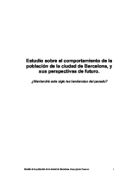Introduction
The Edad de Plata and the regeneration of the novel
At the end of the nineteenth century a great crisis arose; the contemporary intellectuals and writers, wanted to break from their antecedents and look for the new and innovative, within literature and art. Some have named this era within literature as the Edad de Plata1. The Edad de Plata encapsulates the crisis approaching the end of a century, as well as the crisis of 1898 and the desastre: the loss of the Spanish Empire, which included Cuba, Puerto Rico and the Philippines. Moreover, the Edad de Plata covers the bleak political and economic situation within Spain. The crisis facing the end of the century did not only affect Spain; it also affected Europe and the Western world.
This crisis manifested itself in many different forms. The search for a new novelistic genre was because the earlier novelistic genres were outdated; a new world was emerging, and new realities were being conceived. Furthermore, changes in thought were occurring, religion was no longer the only answer to humankind's existence, science was playing a more important role: especially since the appearance of Darwin's book The origin of the species (1859). New sciences were emerging, and new concepts in psychology, such as psychoanalysis with the publication of Freud's The Interpretation of Dreams (1900). There was even a crisis within philosophy; the world could no longer be explained as simply as it had done before. Spanish intellectuals were beginning to accept foreign theories of philosophy, such as the philosophies of Nietzsche and Schopenhauer. Literature also saw foreign influences from Rubén Darío, a Nicaraguan writer, and the French intellectuals and writers. The influence of Rubén Darío, and in particular of his book Azul (1888); was a vehicle for Spanish writers to discover their own traditions and originality. The tradition of social criticism established by writers such as Larra and Jovellanos; was seeing a revival thanks to the desastre. There was also a return to the admiration of the old Spain, the old poets, a re-reading of Góngora. These many influences were producing a crisis amongst the intellectuals and artists in Spain, and many tried to find an escape from this crisis.
The Edad de Plata and the regeneration of the novel
At the end of the nineteenth century a great crisis arose; the contemporary intellectuals and writers, wanted to break from their antecedents and look for the new and innovative, within literature and art. Some have named this era within literature as the Edad de Plata1. The Edad de Plata encapsulates the crisis approaching the end of a century, as well as the crisis of 1898 and the desastre: the loss of the Spanish Empire, which included Cuba, Puerto Rico and the Philippines. Moreover, the Edad de Plata covers the bleak political and economic situation within Spain. The crisis facing the end of the century did not only affect Spain; it also affected Europe and the Western world.
This crisis manifested itself in many different forms. The search for a new novelistic genre was because the earlier novelistic genres were outdated; a new world was emerging, and new realities were being conceived. Furthermore, changes in thought were occurring, religion was no longer the only answer to humankind's existence, science was playing a more important role: especially since the appearance of Darwin's book The origin of the species (1859). New sciences were emerging, and new concepts in psychology, such as psychoanalysis with the publication of Freud's The Interpretation of Dreams (1900). There was even a crisis within philosophy; the world could no longer be explained as simply as it had done before. Spanish intellectuals were beginning to accept foreign theories of philosophy, such as the philosophies of Nietzsche and Schopenhauer. Literature also saw foreign influences from Rubén Darío, a Nicaraguan writer, and the French intellectuals and writers. The influence of Rubén Darío, and in particular of his book Azul (1888); was a vehicle for Spanish writers to discover their own traditions and originality. The tradition of social criticism established by writers such as Larra and Jovellanos; was seeing a revival thanks to the desastre. There was also a return to the admiration of the old Spain, the old poets, a re-reading of Góngora. These many influences were producing a crisis amongst the intellectuals and artists in Spain, and many tried to find an escape from this crisis.







